"The Earth is the only world known so far to harbor life. There is nowhere else, at least in the near future, to which our species could migrate. Like it or not, Earth is where we make our stand."
-Carl Sagan~~
20.04.2024: MAJOR UPDATE TO SEASONAL FORECASTER APP

Our consumer app, The ESD Seasonal Forecaster, is now at version 2.0 release on the Google Play store. The app provides global overviews of temperature and rainfall climate prediction for the next three months.
Additions to V2 include enhanced user flow – and we’ve added global temperature data for three of the world’s most respected climate monitoring centres – NOAA, HadCRUT5 and NASA-GISS. Apple update to follow. Find the new Android release here.
05.01.2024: NEW PUBLICATION – INTERNATIONAL JOURNAL OF CLIMATOLOGY

ESD and UEA publish new research within the Royal Meteorological Society’s International Journal of Climatology. The research presents new techniques to broaden climate projection data sets, which in turn leads to more robust climate mitigation strategy. For full details see our blog piece here. The publication forms part of PhD student [ now graduated ] Sarah Wilson Kemsley’s doctoral research, co-supervised by ESD’s Dr. Craig Wallace, along with UEA and industry partners.
10.07.2023: MULTIPLE MONTHS HAVE EXCEEDED +1.5°C OF GLOBAL WARMING

Monthly-mean global temperatures have exceeded the UN-FCCC threshold of 1.5°C six times since 2016. This includes March 2023, despite La Nina conditions.
These are the first complete months to have broken the ‘safe’ level of warming ascribed by the United Nations.
Full details of our HadCRUT5 analysis here.
23.06.2023: WINNERS!

ESD & Mott MacDonald won first place at yesterday’s Anglian Water Suppliers Awards for Research and Innovation!
We innovated our ESDV3 data engine to provide tailored climate predictions to a variety of industries and users, enabling them to make robust planning and strategy decisions.
Mott MacDonald apply our engine to drive long-range forecasts of surface water stores, enabling Anglian Water to make planning decisions far beyond regular time horizons in the face of increasing climate volatility. The combined service is a UK, if not, global first for water resource planning.
Congratulations to all of the team!
We are committed to help businesses, organisations and communities protect themselves against accelerating global climate change.
17.05.2023: PROJECTION WARNINGS FOR 1.5°C LIMIT BREACH
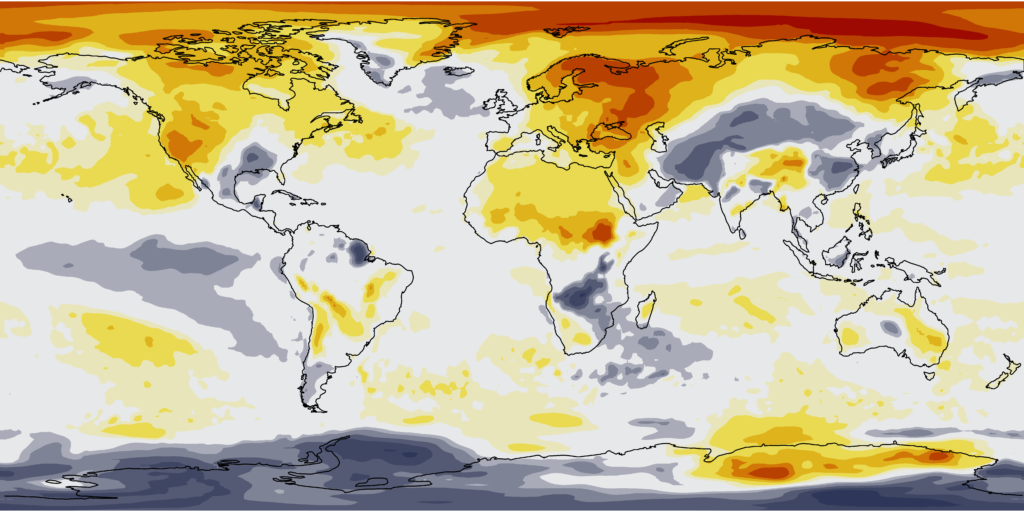
Pacific Ocean conditions are now transitioning to an El Nino state – which will impart a further warming upon the planet in the coming year, in addition to the background carbon-driven warming.
The prospects for remaining below the 1.5°C U.N. warming limit are low. What does this mean for our fight to avoid serious planetary changes? Read our take here.
14.02.2023: SECOND STRATOSPHERIC WARMING. POSSIBLE MAJOR EVENT.
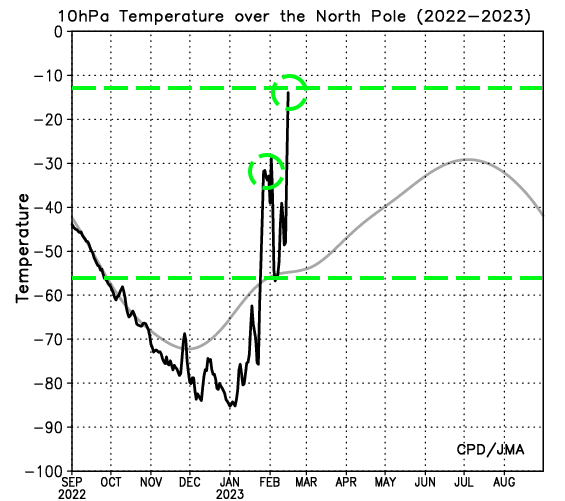
A second stratospheric warming event began over the North pole, 14th February. Forecast models indicate upper-air wind directions may reverse within 36 hours — which would officially mark a ‘major’ stratospheric warming.
If upper-air wind reversals persist, predictability for surface conditions over UK & N. Europe may be possible.
For comparison: In 2018, during the infamous ‘Beast from the East’ episode, upper-air wind reversals persisted for about 10 days before eventual emergence of cold surface weather about 3 weeks later.
Updates as and when we can.
[ 10hPa obs via JMA/CPD ]
6.02.2023: ESD SEASONAL FORECASTER ESDV3 SERVING 98 REGIONS

As of 06.02.2023 our ESD Seasonal Forecaster [ ESDV3 ] is now providing operational data for 98 regions – enhancing our major client’s resilience to near-term climate volatility.
Protect your business with our cutting-edge digital service: 6 international-class long-range predictive systems, tailored output per user to enable informed decisions. Pro-actively prepare for potential climate risk and minimize the bottom-line risk to your organisation, customers and community. Message us now to learn more.
5.02.2023: SUDDEN STRATOSPHERIC WARMING WEAKENS
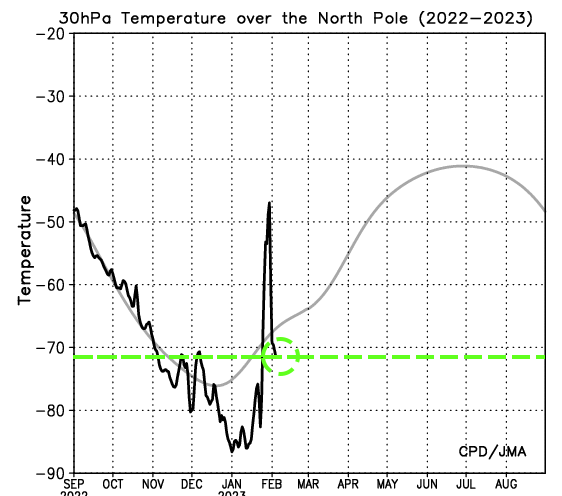
The sudden-stratospheric warming event detected 25.1.2023 appears to be weakening, making a ‘major’ classification – and any influence on surface conditions – unlikely.
Major SSWs have an approximately 30% chance of leading to severe cold conditions over the European sector, the most pronounced recent example being in March 2018.
[Observed time series via JMA CPD lab]
4.02.2023: SUDDEN STRATOSPHERIC WARMING DETECTION
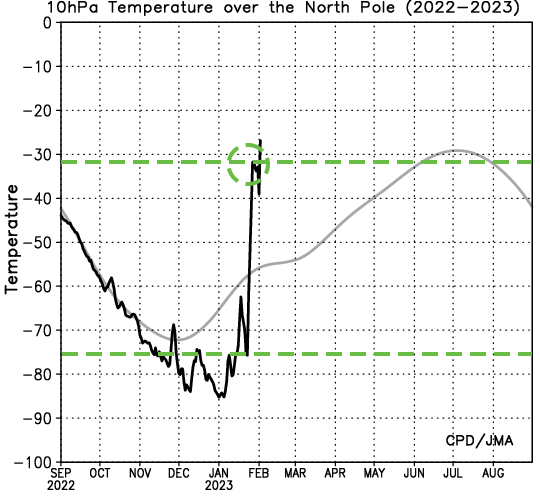
The first sudden-stratospheric warming of northern-hemisphere winter 2022/2023 has been detected by JMA, originating 25.1.2023.
Current status is a ‘minor event’ — if elevated to ‘major’, predictability for surface conditions over the European sector may be possible for the next 3-to-4 weeks.
3.02.2023: ECWMF-SEASV SIMULATION OF SW-USA COLD ANOMALY
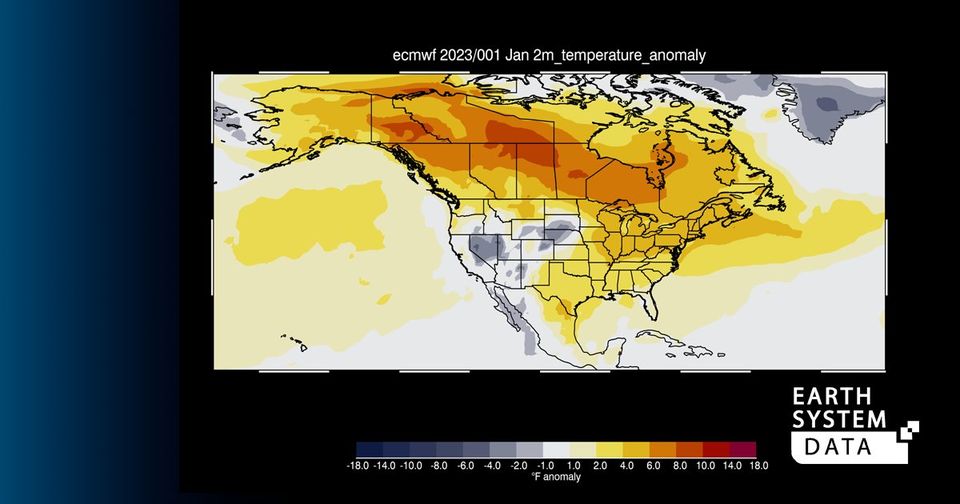
ECMWF-SEASV, one of six systems in our ESDV3 service, simulated southern, cold incursions which dominated south-western USA this week.
The magnitude of the cold anomaly appears mild in the forecast since the forecast is for the month as a whole – the cold snap being ironed out by other parts of the month which were normal.
Long-range forecasts of this type predict average conditions for the month as a whole and are increasing in their predictive skill. They are not, however, designed to indicate when in the month particular events will occur.
#climateprediciton
31.12.2022: EUROPEAN WARM ANOMALIES CHARACTERISE DECEMBER
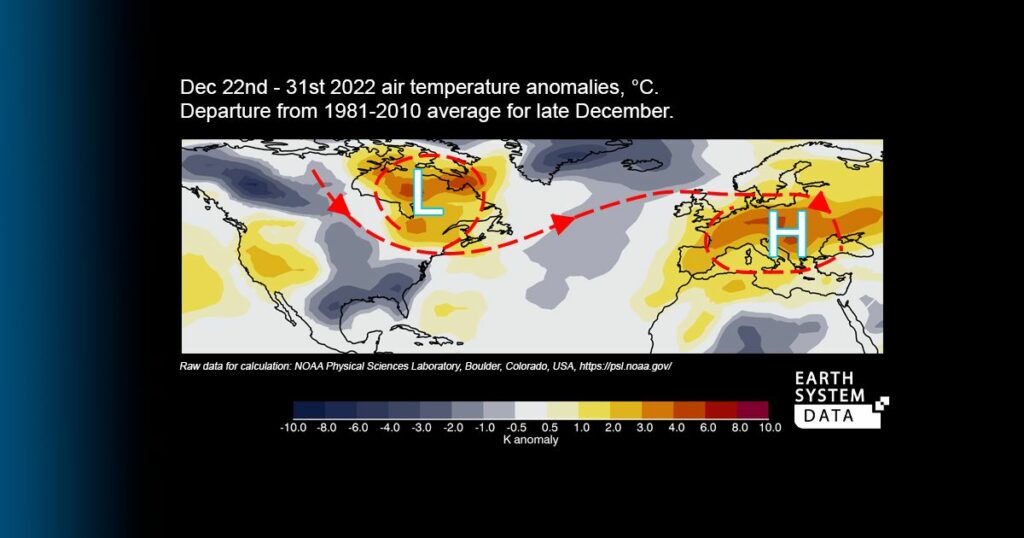
North American / European sector, latest run ESD global monitoring code, 22nd December – 31st December 2022.
—————————
Expansive European heat conditions, up to 5°C warmer than normal; multiple cities report new maximum temperature records.
Colder-than-normal conditions evident for this time window, central North America, as a result of prevailing air flow [ red marker annotations ], counter-balanced by warm anomalies over Canadian Archipelago.
Context: As with summer heat events, warm anomalies arising from these circulatory patterns – not unusual in themselves – are now being amplified by background planetary heating caused by human modification of the atmosphere.
In line with climate predictions, affected land surfaces are now rapidly transforming to new states: at least 1400 Swiss glaciers have halved in mass since the 1930s.
https://www.dw.com/…/switzerland-disastrous…/a-63267198